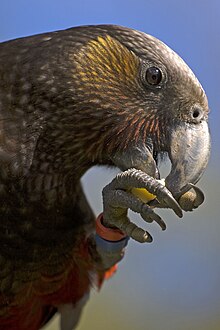
New Zealand is geographically isolated, and originally lacked any mammalian predators, hence parrots evolved to fill habitats from the ground dwelling kākāpō to the alpine dwelling kea as well as a variety of forest species. The arrival of Māori, then European settlers with their attendant animals, habitat destruction and even deliberate targeting, has resulted in their numbers plummeting. Today one species is on the brink of extinction and three other species range from Vulnerable to Critically Endangered, all impacted by invasive species.[1] Further parrot species were not introduced by acclimatisation societies, but occasional releases, both deliberate and accidental, have resulted in self-sustaining populations of some Australian species. New Zealand was identified among the highest priority countries for parrot conservation in the world, due to its parrot diversity, endemism, threats, and having more threatened parrot species than expected.[2]
- ^ Olah, George; Theuerkauf, Jörn; Legault, Andrew; Gula, Roman; Stein, John; Butchart, Stuart; O’Brien, Mark; Heinsohn, Robert (2018). "Parrots of Oceania – a comparative study of extinction risk" (PDF). Emu - Austral Ornithology. 118 (1): 94–112. doi:10.1080/01584197.2017.1410066. ISSN 0158-4197.
- ^ Olah, George; Butchart, Stuart H. M.; Symes, Andy; Guzmán, Iliana Medina; Cunningham, Ross; Brightsmith, Donald J.; Heinsohn, Robert (2016). "Ecological and socio-economic factors affecting extinction risk in parrots". Biodiversity and Conservation. 25 (2): 205–223. doi:10.1007/s10531-015-1036-z. ISSN 0960-3115.